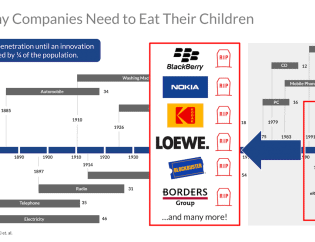
0. What you will learn
In one of my last videos, I explained why technology matters less than you think. Today, I would like to further elaborate on some of the arguments mentioned in this video.
This article will explain:
- Why companies are not and will not become innovative by using technology and why there's very little opportunity to gain a lasting competitive advantage against competitors,
- The very dangerous assumption of why an overemphasis on a technology-driven strategy does not translate into a lasting competitive advantage, despite the increased importance of IT,
- What distinguishes proprietary from infrastructural technologies,
- How competitive advantages erode over time, by looking at past technologies,
- What makes IT a simple commodity input and not a strategic advantage to enterprises,
- Why companies need to focus on threats rather than opportunities and should keep IT expenditure in check,
- Why companies should not be first-movers and why there’s no shame in following your competitors when it comes to adopting new IT technologies.
But before we start, we should first define and clarify a few important terms we’ll be using throughout this article.
When I use the term “information technology” (IT) in its most basic form which includes technologies used for storing, retrieving, transmitting, and manipulating data. And when the more generic term “technology“ is used, it will refer to technologies such as hardware and software that are used within the context of IT.
1. Preface
If you think your company will be or is innovative by using technology as a competitive advantage that's going to last, then you're in for a rude wake-up call.
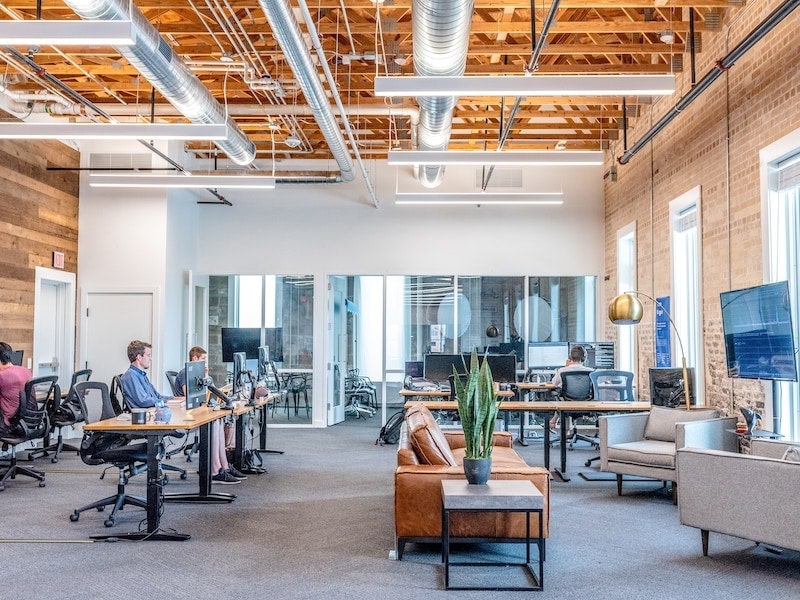
Most agencies, digital consultancy, and technology companies would strongly disagree with this argument - for obvious reasons. They wouldn’t want this idea to be broadly disseminated among informed companies as this would reduce their product or service to a commodity.
Remember, the aforementioned companies have vested interests in selling lots of technology products and services to businesses, especially with all the hype around “digital transformation”. Nowadays, every company has something to offer for this over-hyped an overused topic. And of course, these vendors are going to market their technology offerings as something with which companies can gain a competitive advantage. However, let’s be honest: Competitors are quite adept at copying any technological innovation.
But let’s start from the beginning and explain the reasoning behind this argument, shall we?
2. Why the increased importance of IT does not translate into a lasting competitive advantage
Ever since the invention of the first microprocessor in the late 1960s, it created many technological breakthroughs, ranging from personal computers (PCs), LAN, WANs, smartphones, software, and of course, the internet - all of which have transformed the world in one way or another.
Today, no one would try to dispute that these technologies have become the backbone of our economy. It connects individuals and local businesses to their supply chains and to the customers they serve around the globe. Almost all revenue of today’s enterprises are derived with the help of computer technology. And companies have come to view this technology as absolutely critical for conducting business. This fact is reflected by Gartner's worldwide corporate IT spending forecast (July 2017; see chart below), where the IT expenditure was projected to be $3.6 trillion in 2018.
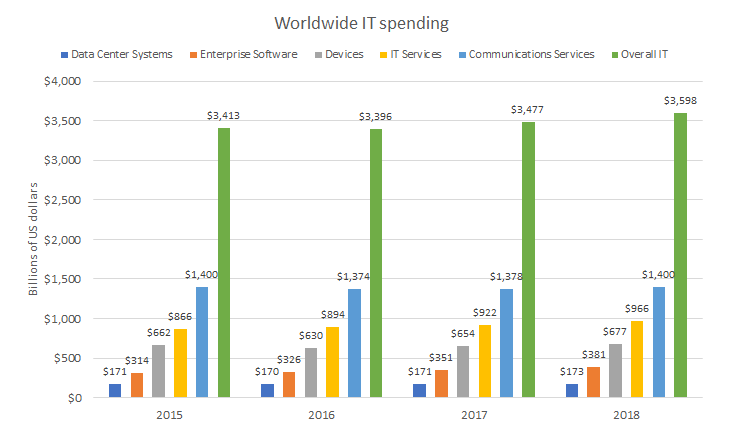
Data: Gartner / Chart: ZDNet
Companies’ relationship with IT goes much further than simple spending figures. How executives view IT today has also changed dramatically over the past 30-40 years. Before, top executives regarded computers as glorified typewriters that their lower ranks (secretaries, data analysts etc.) used to perform their job. Back then it was rare for C-Level executives to even touch computers themselves. And even today, you’ll still (on rare occasions) see CEOs have their secretaries print out their emails for them.
Fast forward to today and all this has dramatically changed. C-Level executives now view IT as a strategic advantage with which they can gain a competitive edge by incorporating IT into their business models. And with the recent “digitalization” movement this view has been even more pervasive. Most CTOs hire IT and strategy consultancies to help them leverage their IT investments to differentiate themselves and gain an advantage from their competitors.
But behind this view lies a very faulty and dangerous assumption, one that assumes that because the importance and availability of IT have increased, so too has its strategic importance. Even though this assumption seems very plausible and even intuitive, it’s still wrong.
What makes a technology, or any resource for that matter, truly strategic and creates a sustained competitive advantage, is not its ubiquity, but its scarcity! A company only gains a competitive advantage when it does something that its competitors don’t have or simply can’t replicate.
Granted, some companies use technology more intelligently than others. That's certainly true and a valid point, but that's also true with any other business resource. So this fact by itself does not tell you whether the resource itself provides any kind of strategic advantage or has any kind of strategic value.
Key Takeaways:
- Agencies, digital consultancies, and technology companies have strong, vested interests in selling technology products and services to businesses.
- The annual IT speeding of companies has continued to grow almost uninterrupted ever since the first computer was invented.
- Most CTOs hire IT and strategy consultancies to help them better utilize their IT and to differentiate themselves to gain an advantage from their competitors.
- Behind this view lies a very faulty and dangerous assumption, one that assumes that because the importance and availability of IT have increased, so too has its strategic importance.
- For technology or any resource to be truly strategic and able to create a sustained competitive advantage, it needs to be scarce, not ubiquitous, and do something competitors don’t have or simply can’t replicate.
3. How competitive advantages erode over time - A brief history lesson
Before we can talk about the erosion of competitive advantage, we need to distinguish between proprietary technologies from infrastructural technologies.
In simple terms, proprietary technologies are owned by a single company. A good example of this is a patent that is held by an e.g. pharmaceutical company for a specific active ingredient in a drug. The same applies to processes or materials. If a manufacturer develops an innovative process or material that its competitors find hard to replicate, it has a long-term strategic advantage. As long as it remains a protected and proprietary technology it enables this company to earn higher profits than its competitors.
Infrastructural technologies on the other hand provide far more value when shared than when used by a single company. To illustrate this point, let’s assume a company in the early 19th century held all the technology patents to create a railroad. This would allow it to build a proprietary railroad network between its supply chain and its factories using its own trains and carriages. And it would probably operate much more efficiently than with multiple operators involved. But for the economy as a whole, the value created by such a scenario would be insignificant compared to the value created by an open railroad network, connecting much more companies and (potential) customers. These inherent characteristics and economics of infrastructural technologies, make it almost inevitable that technologies such as railroads, telephone lines or electricity, will be shared with all and become part of the overall business infrastructure.
Baltimore & Ohio Electric Engine
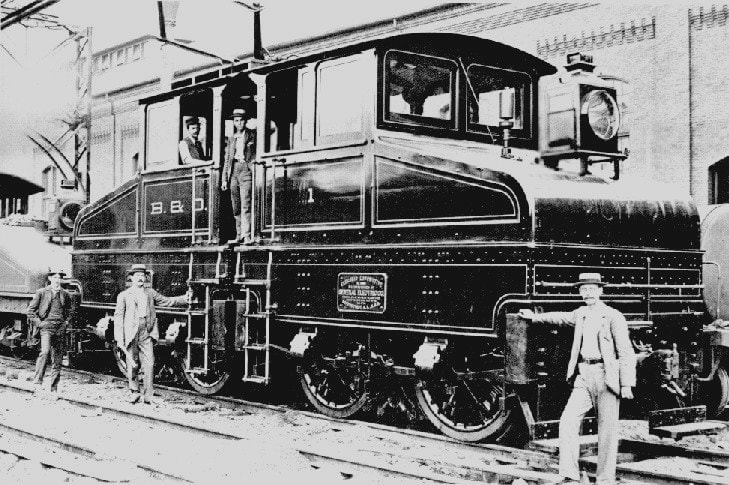
Source: Wikipedia
In the beginning, infrastructural technology acts more like proprietary technology. This is due to the fact that technology in these early stages is often limited in terms of access through physical limitations, intellectual property rights, high costs, or simply lack of standards. During this time a company can use this technology to gain competitive advantages over its rivals.
This is exactly what happened during the construction of the first electric power station in the 1880s and the electrical grid in the early 20th century. Electricity was still very scarce during this time frame. And as such, manufacturers that were able to use electricity by building their factories close to power generating stations gained an advantage over their rivals. By having a superior grasp of new technology companies can also steal market share from their competitors. Again, the early introduction of electrical power serves us as an excellent example.
Brush Electric Company's Central Power Plant
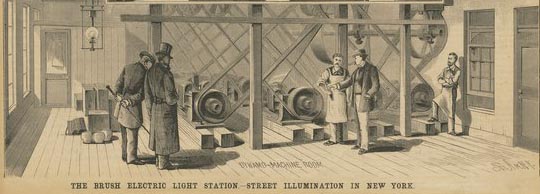
Source: Wikipedia
Up until the end of the 19th century, most factories ran on water pressure or steam to operate their machines. Power came from a single, fixed source — a water wheel mounted on the side of a mill and required a complex set of gears to distribute it to each individual machine throughout the factory. However, when electric generators became available, many factories simply adopted them as a replacement for their single power source, using them to power their existing system of gears. Manufacturers that recognized the potential of this new technology, realized that electricity could easily be connected directly to the machinery itself. By installing electric motors in their machines, they were able to throw out the inflexible and expensive gear systems, making them overall more efficient than their slower competitors.
Beyond helping companies operate more efficiently, infrastructural technologies also enabled large market changes. During the construction of the first railways, it was already possible to transport goods over long distances via steamships. So most companies assumed that rail transport would just be an incremental improvement over the steamship.
However the greater speed, capacity, and reach of trains fundamentally changed the American industry. Instead of simply shipping raw materials, it became commercially viable to ship finished products over long distances, creating the mass consumer market. Companies that were quick to capitalize on this opportunity built large-scale, mass-production factories, which allowed them to put smaller, local factories out of business.
The problem, however, is that managers falsely believe that these advantages will continue indefinitely. However, in reality, these advantages from infrastructural technologies only last very briefly. Once such technology begins to have broad appeal, its buildout and maturity increase at an almost exponential rate, as we’ve seen with railroads, telegraph, and power lines.
So, essentially the question becomes: How long can a company keep those advantages proprietary?
It's very important to take the development over time into account where technology becomes more standardized and as innovation progresses its ability to provide companies with distinction advantages that can be used to defend against their competition, fades.
Once the buildout begins to subside, the opportunity to gain a competitive advantage from a particular technology has mostly vanished. As investment increases, so does the competition, leading to more overall capacity, falling prices, making the technology broadly accessible and affordable. At this point, the market forces users to adopt the universally agreed standards, rendering proprietary alternatives obsolete. Even more, both technology and its use (often in the form of best practices), essentially become, commoditized.
For a short period, these newly emerging infrastructural technologies can provide innovative companies with real competitive advantages. But as the availability of these technologies increase and their associated costs decrease, they quickly become commodities. From a strategic standpoint, they don’t matter anymore. And the same thing is happening with today’s digital technologies.
The cost of storage, cloud computing and other services have not only become affordable but also more accessible to all. The same is currently happening with technologies such as machine learning, artificial intelligence, etc (e.g. machine learning via AWS or AI via Google Cloud). What is a strategic resource, will quickly become a commodity and a simple cost of doing business that must be paid by all, but does not provide any unique advantage over the other participants.
Many will agree to part of the argument, in that technology is becoming a commodity in certain areas, but there's innovation happening at other levels and that combining technology and innovation really does lead to a competitive advantage. These people will also cite a few companies that they perceive to be ahead of the competition because they use technology so effectively. And yes, without a question, there are advantages when companies are very adept at utilizing technology.
But by simply reducing their competitive advantage to superior use of technology actually does them a huge disservice. Instead, their advantage comes from very distinctive and basic business models which were often developed before the use of any particular technology. A lot of the innovative use of technology, as well as many other resources and processes, are needed to increase and strengthen a company’s advantage.
Key Takeaways:
- Proprietary technologies are owned by a single company e.g. pharmaceutical company that has a patent for a specific active ingredient. If competitors find this technology hard to replicate then a company has a long-term strategic advantage that enables it to earn higher profits than its competitors.
- Infrastructural technologies provide far more value when shared than when used by a single company e.g. railroads. The value created by keeping this technology priority is insignificant compared to when it's shared.
- These inherent characteristics and economics of infrastructural technologies, make it inevitable that technologies such as railroads, telephone lines or electricity will be shared and become part of the business infrastructure.
- In the beginning, infrastructural technologies act more like proprietary technologies, due to the fact that in these early stages, these are often limited in terms of access through physical limitations, intellectual property rights, high costs, or simply a lack of standards. It’s only during this time a company can gain a competitive advantage over its rivals.
- Managers falsely believe that the advantages of infrastructural technologies will continue indefinitely. But once the buildout begins to subside, the opportunity to gain a competitive advantage has mostly vanished.
- By simply reducing a competitive advantage to the superior use of technology actually does companies a huge injustice. Their advantage comes from very distinctive and basic business models which were often developed before the use of any particular technology.
- The potential for technology to create a strategic and differential competitive advantage for a company deteriorates as it becomes more accessible and affordable to all market participants.
4. Why IT is the ultimate commodity
IT too has all the characteristics of an infrastructural technology. Its inherent characteristics lend itself to even faster rates of commoditization. In simple terms, IT is a digital transport medium by which information is carried from point A to B, just as railroads or power grids carry goods and electricity. And as such, it is much more valuable when shared than when used in isolation.
If we take a brief look at the history of IT, we can see that interconnectivity and interoperability have increased over time - from large mainframes and time-sharing models to standard PC-based LANs, WANs and the internet itself. And each evolution created more standardization. Today’s enterprises try to avoid customizations of their IT system as the benefits would be massively outweighed by the costs of isolation.

IT is highly scalable (in most cases at virtually no or little cost) to a point where proprietary systems and applications are almost doomed to fail. IT can be considered the perfect commodity, perfectly reproducibly at the byte level. When companies buy standard software applications they also purchase the business processes embedded into that software as well, making these too, replicable. Furthermore, most all software used in modern technology stacks are either Open Source or based on it. The cost savings and benefits of interoperability from generic applications far outweigh the advantages of customization.
Once a company outsources a process they’re giving it away to a vendor who can replicate it for many different companies and including its competitors. So if you're a company that has distinguished itself by the superior use of processes, your traditional advantage will erode by outsourcing IT processes and will bring other companies to competitive parity.
The actual large productivity gains come early with the first iterations of the technology. It may take some time and it usually does to change a companies’ organization and processes to take advantage of those technologies. But once the process has been automated the additional returns from new advances in the in that process automation go down very quickly.
One can observe this progression of commoditization in hardware and software, moving from fairly complex to more standardized hardware or from fairly complex enterprise applications to simple software.
The internet has even further accelerated this commoditization of IT by providing a distribution channel for generic software. It’s almost the norm for companies to fulfill all their IT needs by purchasing web-based services (SaaS) from third-party vendors (see chart below), similar to how they currently buy electricity or telecommunication services. Large technology businesses such as Microsoft or IBM are trying to position themselves as IT utilities, proving companies with all their essential business applications.
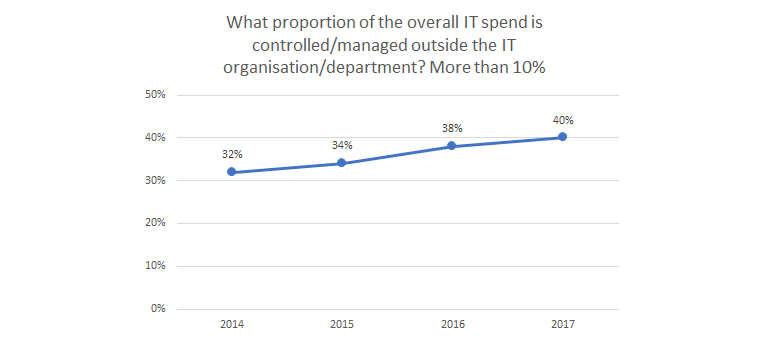
Data: Harvey Nash-KPMG / Chart: ZDNet
Lastly, Moore’s law predicts that the number of transistors will double every two years, increasing the available processing power at a fraction of the cost. Over the last decades Moore's law has shown us exactly that: Technological progress advances at an exponential pace (see chart below). But at the same time, the cost of this technology comes down almost equally as fast.
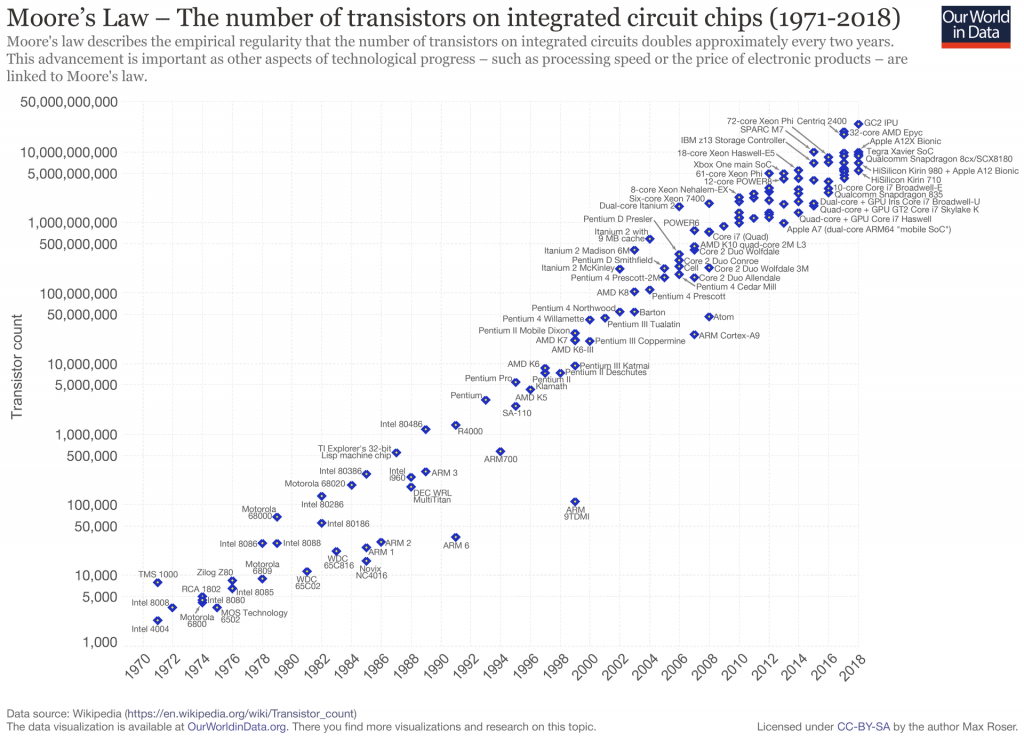
Source: Wikipedia
These massively decreased costs have essentially democratized computer technology but have also leveled market entry barriers for competition. Even the most state-of-the-art IT system quickly becomes available for all to enjoy. So it shouldn’t come as a surprise that IT has not only closely mimicked the buildout of past infrastructural technologies, but has also been equally as impressive.
Still, we’ll continue to see infrastructural innovation, but this infrastructure will be shared by all companies and will become much more reliable and more efficient over time. And they're not going to be proprietary to a single business.
Key Takeaways:
- IT shares all the characteristics of an infrastructural technology. Its inherent characteristics make it the perfect commodity, perfectly reproducibly at the byte level, lending itself to even faster rates of commoditization.
- The distinguishing or superior use of technology will erode by outsourcing IT processes and will bring other companies to competitive parity. Once the process has been automated or outsourced, the additional returns from new advances diminish very quickly.
- The internet has accelerated this commoditization of IT by providing a distribution channel for generic software and massively decreasing costs and thus democratizing computer technology. It has also leveled market entry barriers for competition. Even the most advanced IT system quickly becomes available for all.
5. Why companies should not be first-movers in adopting new IT
Just like previous infrastructural technologies, IT provided early adopters with competitive advantages in the early buildout phases when it could still be “owned”, similar to proprietary technology. This was the case when mainframe computers were still in use. Some of these innovative systems used proprietary software that ran on mainframe computers, effectively locking out competitors, leading to better financial results for companies that could utilize them. These competitive advantages are only possible because they capitalize on the characteristics of infrastructural technologies that are common in the early phases, which are associated with the high cost and a lack of standardization.
Some examples of companies that have gained such advantages in the past were American Airlines with its Sabre reservation system, Federal Express with its package tracking system or Reuters with its financial information network in the 1970s. They were able to gain a specific advantage to leapfrog the competition in one key area.
But the barriers that proprietary applications and systems provide in the early stage against the competition can dissolve quite rapidly (sometimes within just a few years), making it very unattractive to their end-users and uneconomical to their owners. This quickly leads the “competitive advantage” to become a liability rather than an asset.
Nowadays, the opportunities of gaining IT advantages are already decreasing. Best practices are quickly being replicated in software or otherwise. Sure, industries and markets will continue to evolve and some will completely transform, similar to what we’ve seen in the music or media industry. But if it’s one thing that history has taught us over and over again, it’s that the power of infrastructural technology to transform industries and markets always decreases as its technology becomes more accessible to all.
Nobody can predict exactly when a buildout of a particular infrastructural technology is nearing its end, but there are many indicators that show the buildout is closer to its end than its beginning.
- When the technology outperforms or over-satisfies customer needs, also leaving room for disruptors to enter the market.
- The price of fundamental IT needs has reached a level where it's affordable to almost everyone.
- The total capacity has met or is outstripping the demand.
- IT vendors try to position themselves as commodity suppliers or even as utilities.
- And, the most obvious sign is when the investment bubble pops.
Even in this environment, there might still be a few companies left that are able to gain an advantage from highly specialized applications, but those will remain the exception rather than the norm.
Key Takeaways:
- Competitive advantages that derive from the characteristics of infrastructural technologies are only possible in the early phases, which are associated with the high cost and a lack of standardization.
- The barriers that proprietary applications and systems can provide in the early stage against the competition can dissolve quite rapidly, quickly turning the competitive advantage into a liability rather than an asset.
6. What should companies do?
When we take a look at how infrastructural technologies have evolved throughout history, we can clearly see that these technologies stopped providing the basis for any competitive advantage. Yet, these technologies are still extremely important in that all companies have to maintain competitive parity and have to continue to invest large sums of money, but their ability to distinguish themselves from the competition diminishes.
6.1 Focusing on threats rather than opportunities
Companies are not going to gain any long-term competitive advantage through the distinctive use of technology, but they can certainly put themselves at a disadvantage by using it carelessly by disregarding things like security and other vulnerabilities. Therefore, companies should spend less on technology and instead focus more on threats than opportunities.

Once a technology (or any resources for that matter) becomes essential to stay competitive, but insignificant to the overall strategy, the risks it creates become more important than the benefits it provides.
No company in the world builds its strategy around the usage of electricity, but even a short blackout can have devastating effects. This same applies to IT systems. Even a small disruption in its operation or a security vulnerability can have debilitating effects on a company. In severe cases the company can lose its ability to make or deliver products, damaging its reputation - often costing the company millions of dollars.
The task of ensuring what could go wrong is certainly not as sexy as speculating about the “next big thing”, but arguably the more crucial one. But the more important task, albeit not so obvious one, is overspending on IT.
6.2 Keeping IT spending in check and having patience
There are many examples of companies introducing SAP for example that have gone bankrupt from this decision - essentially overspending on this particular technology. Even though IT is a commodity and it costs to continue to fall, the fact that IT is essentially integrated into every major business function, also means it will continue to consume a large part of corporate spending budgets. Simply staying in business often requires large investments in IT. Therefore it’s important to distinguish essential investments from ones that are unnecessary or even counterproductive.
So again, when a resource becomes critical to stay competitive, but insignificant to the strategy, the risks it creates become more important than the benefits it can provide.
If companies can't capitalize on the innovative use of new technology to defend this advantage for a significant period of time in order to pay back those higher upfront costs of being a first-mover, then it makes much more sense to wait until the costs have come down.
There’s no shame in letting your competitors make the mistakes, take on the risks as the technology matures and standards become more reliable, while at the same time, its costs go down and you can achieve the same level of capability for much less money. All companies need to do to employ this strategy is a little bit of patience. So, in most cases, the tortoise beats the hare.
On a more practical level, companies need to pay much more attention to the ROI on their IT investments. Even years ago the processing power of computers and the features of the most-used applications have reached a level that is more than sufficient for 90% of employees. In addition, more and more applications are available as web services, only requiring a simple Web browser to use.
Despite this fact, companies continue to spend roughly the same amount on hardware and software upgrades, instead of looking for cheaper or even open-source alternatives. But to be fair, this is also due to the fact that IT vendors have become extremely good at convincing enterprises to upgrade their more than adequate IT systems.
Companies, similar to consumers, have a fear of missing out (FOMO for short) on the newest technology. There is a fear that they will be left behind with old legacy technology. However, in most cases, these fears are completely unfounded. Still, executives are worried that being cheap when it comes to IT, is going to hurt their established position. Some studies of corporate IT spending clearly show that more IT spending rarely translates into better company performance.
The CEO of Oracle, Larry Ellison, has even admitted this fact way back in 20021:
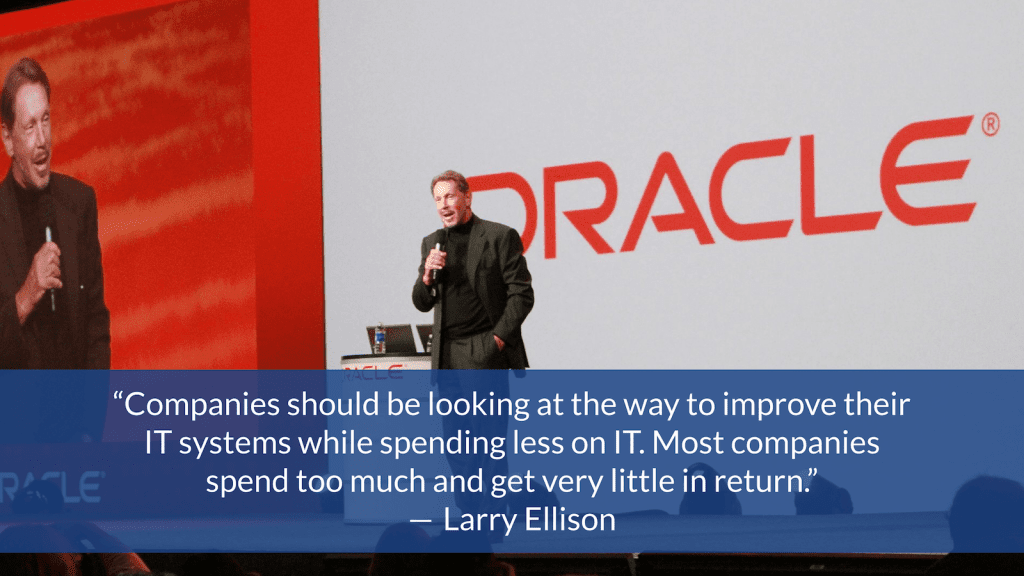
It seems to confirm the old adage: It’s not how much you spend, but how well you spend it.
A good example of this philosophy is Wal-Mart. Wal-Mart never invested in the most state-of-the-art technology, but instead waited until standards and best practices were well established. Essentially they let their competitors burden the risk and high costs of new technology and overtook their rivals by spending much less and getting more in return.
So it’s better to follow than to lead when it comes to IT expenditure.
Key Takeaways:
- Companies should focus on threats rather than opportunities. Once a technology or any resources becomes critical to stay competitive but insignificant to the strategy, the risks it creates become more important than the benefits it can provide.
- If companies can't capitalize on the use of new technology to defend this advantage for a significant period of time in order to pay back those higher costs of being a first-mover, then it makes more sense to wait until the costs have come down.
- Let your competitors make the mistakes and take on the risks as the technology matures and standards become more reliable. As costs decrease you can achieve the same level of capability for a fraction of the cost. For this reason alone, companies need to pay much more attention to the ROI on their IT investments.
- Studies on corporate IT spending clearly show that more IT spending rarely translates into better company performance.
7. Final Words
Many argue and believe that IT has become the most transformative technology in history. I would argue that that’s just not the case. If you take a look at how companies operated before, you can clearly see that technologies such as electricity for example had a much more dramatic impact. Disagree? If I forced you to pick between your smartphone or all of your light bulbs or running water in your house, you’d probably get rid of your smartphone. Case in point.
I’m not saying that IT hasn’t had a tremendous impact on our society, but companies tend to put IT on a pedal stool. IT, or any technology, is not magically going to solve the underlying and fundamental problem. Just because you buy the most advanced camera doesn’t make you a pro photographer or simply buying a formula 1 race car doesn’t make you Michael Schumacher. Technology has the tendency to amplify existing skills and core competencies, or the lack thereof. However, there are no shortcuts or free lunches in life, even with today’s technology.
Furthermore, if companies continue to only focus on digital technologies, it automatically implies that they already know the solution before they’ve identified the underlying problem or customer need. Sure, if all you have is a hammer (focusing on digital technologies), everything is going to look like a nail (the solution is always related to digital technologies). See “Maslow's hammer” for further reading.
The important thing to remember is this: If you’re trying to gain a competitive advantage by solely focussing on technology, you’re not only putting blinders on but also shooting yourself in the foot in the process. What if something, that has nothing to do with technology, gives you a much effective competitive advantage? You’d miss the opportunity to identify this potential solution, simply because you are focussing on digital technologies and nothing else.
In the end, most companies will completely disregard the advice in this article, but that’s to be expected. The majority will always follow the herd and claim they are not. But if you follow the herd, you will eat…well let’s say it’s not grass...
Follow the Author on LinkedIn | XING |
The article was originally published on LinkedIn.
Let me hear in the comments what aspects in this article you found to be the most relevant. And which ones surprised you the most?
If you enjoyed this article, don’t forget to like and share so other people in your network can enjoy this guide as well. You might also like my other articles here or my latest one:
Der Mittelstand braucht keine digitale Transformation! (German)
Why Companies Need to Eat Their Children - A Comprehensive Guide to Disruption
Why Uber Is Not Disruptive and What Almost Everyone Around You Gets Wrong About It
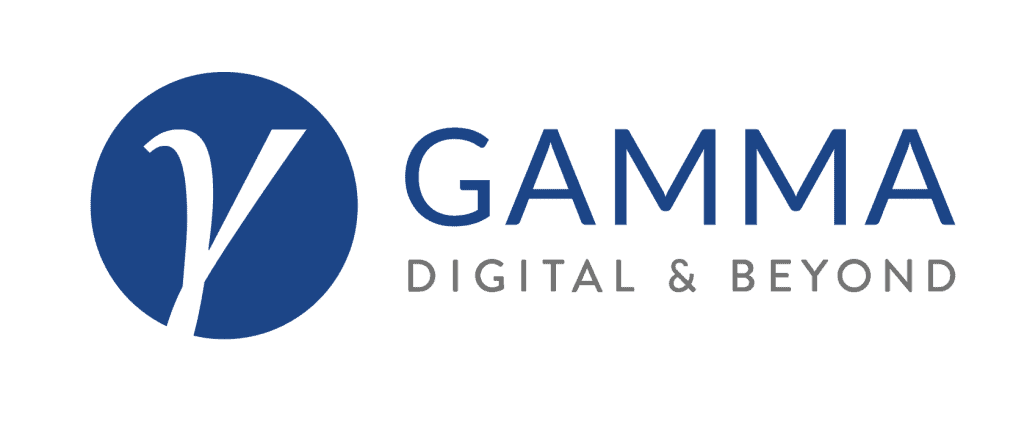
GAMMA Digital & Beyond® is an innovation and transformation consultancy. We enable small, medium-sized and large companies (a.k.a. “Mittelstand”) to accelerate, incubate and scale their innovation cycle and transformation process.
We offers advisory and consulting on both innovation and digital transformation topics. With our execution and results focused approach to innovation, we enable companies to develop working, commercially viable products/services and sustainable business models.
Enabling our clients to drive forward innovation themselves is our primary goal. This transformation is about changing the entire organization and mindset in order to remain adaptable to the ever ever-changing.
Follow GAMMA Digital & Beyond on
Photo Credits:
- unsplash.com
- Wikipedia



